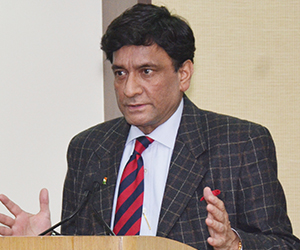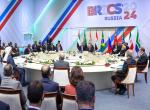The hype over the nuclear deal has obscured the main achievement of the Obama visit: this is in the Joint Strategic Vision Statement for the Asia-Pacific and Indian Ocean Region, to give the full name of the separate document issued by the two leaders. This is not to gainsay the importance of civil nuclear cooperation, or the understandings reached on defence and economic cooperation. But when heads of state and government get together, they should, and do, talk about the larger strategic environment in which their engagement takes place – and in the current regional situation, no partnership is more important for India and its security than the American one. There is little that is new in the document, but the message is in the fact that a separate document on this issue has been issued.
The Vision document begins by declaring that a closer partnership between the two countries is indispensible for peace, prosperity and stability in the Asia-Pacific and Indian Ocean regions. Of the three, the word “stability” carries the most meaning, for it lays stress on the need for the current status quo not to be challenged or disturbed. The geographical sweep is also impressive: from Africa to East Asia, from Central Asia to South-East Asia. It also addresses the high-voltage issues of freedom of navigation and over-flights especially in the South China Sea by endorsing these principles and linking their legal basis with the UN Convention on the Law of the Sea [UNCLOS]. As is well-known, China does not accept the applicability of UNCLOS to the South China Sea, but has its own claim to the entire Sea, based on flimsy and un-provable evidence.
The document also endorses India’s interest in joining the Asia-Pacific Economic Cooperation [APEC] forum, and enjoins on both countries the development of a road map to work together with other partners to face the diplomatic, economic and security challenges facing the region. The main Joint Statement also makes a reference to the India’s ‘Act East’ policy and the US “Rebalance” and points to the synergy between the two. This is welcome, and presumably, will also cover the Trans-Pacific Partnership (TPP) that the US is driving in the Asia-Pacific region. Several of our main trade and investment partners are in it, and if India were to be left out, it would stand to lose substantially in terms of trade and investment – of the order of tens of billions of dollars. We need to take account of the fact that there is a similar free-trade agreement being worked out with the European Union, which is another important market and source of FDI for India.
The Chinese, the Turks, the Africans have all expressed their interest in being part of these new arrangements, but have been kept out so far. We, who have been invited to join TPP, are hanging back, presumably because of the high-standard labour, environment, and IPR protection requirements – this needs to be rectified, and we could at least join in as observers, the way Canada and Japan began their association. The just-released US National Security Strategy lays great emphasis on the Rebalance and the TPP, and on the growing relationship with India, as if to emphasise the positive outcomes of the visit. We need to move quickly on this, since TPP appears to be reaching its conclusion, and then we shall once again be the outsider, seeking to get in after the doors are shut.
The only issue that causes some concern is the treatment of the AfPak region. The talk and references on this are lukewarm from the stand-point of our interests, and confined to bromides about stability in Afghanistan and the need to curb terror groups. The more troubling bit is about the energy linkage between South and Central Asia. This is a high priority for America, and has been for some decades now, ever since the emergence of an independent Central Asia. The strategic purpose is to block out Russian and Chinese influence in this region. But it will necessarily involve transit through Pakistan, and that country will certainly use this leverage for its strategic purposes, and these are inimical to our interests.
Indians should not get beguiled by all the recent talk about a new approach from Pakistan after the Peshawar school terror attack of last December. There have been many such false starts in the past – the ineluctable reality is that towards India, nothing has changed. As this is being written, there are reports that we are proposing to resume the dialogue with Pakistan; the proximity of this with the visits of Secretary of State Kerry and Obama is bound to raise questions. As it is, we seem to have accepted the Pakistani contention that since we called off the talks, the onus is on us to resume them.
It would be important to be clear that Pakistan is not about to change its approach towards India, not until we take action to change the calculus in Rawalpindi of their costs and benefits of enmity towards India. And the closer we get to the US vision in the Asia-Pacific, the more concern there will be in China as well, as was in evidence in the Chinese media during the visit itself. This is the real security contingency we need to prepare for, and need to know how far we can count on our friends and partners in the Asia-Pacific in such a situation.
In general, it needs to be emphasised that the US is still the driver of the global economy, and can thus be a stimulus for the Indian economy, especially for the ‘Make in India’ campaign. If indeed manufacturing is to reach somewhere near the scale that the Chinese economy did with such success, India will need not just its domestic market, but will also need the huge market that the US represents. This was the underpinning of the Chinese economic success: even today, but for the US, China would have a deficit in its balance of trade with the rest of the world, and its positive trade balance is the real driver of its economy. Therein lies the true importance of the US as an economic partner. In a welcome decision, we have agreed to raise the Strategic Dialogue to a Strategic and Commercial Dialogue.
There are three issues that needed to be raised with the US side regarding the current problems faced by Indian companies. The first is the issue of IT-enabled services, where Obama has been active in discouraging out-sourcing. The second relates to the problems faced by our Pharmaceutical companies, especially in the area of generics. This is something that is truly a win-win, because it would help in reducing the costs of Obamacare. And yet, there appears to have been no real solution to this issue. The third is the question of revising the quotas and voting rights in the IMF and the World Bank. The US Congress is holding up ratification of the changes, so it is to be hoped that there was some understanding reached on this. Of course, the US Congress is now in Republican control, so we need to work with the leadership of the two Houses directly as well.
Defence is also a sector of growing importance for bilateral ties and for strategic purposes. The US has emerged as the largest supplier of hardware in the last few years, and this trend is likely to stabilise. A few, admittedly minor, new “pathfinder” joint projects have been picked out to get the pump primed for joint production, and will lay the foundation for deeper collaboration in the future. In 2013, the two countries agreed to give each other the same treatment for defence cooperation purposes, as we give to our closest partners; it is time to implement this, and move on to more substantial work beyond the pathfinders.
It is reported that the US has also revived its interest in the operational agreements like CISMOA, which had gone into deep freeze over the past few years. And, of course, there is the issue of military-to-military links, including the posting of an officer of the Indian Armed Forces at the US Central Command HQ. It is time to resolve all these and move on to the next higher level of defence cooperation that the two countries need to achieve in their own respective interests. There is absolutely no threat to our cherished nonalignment or strategic autonomy in any of this.
Now for a brief discussion on the nuclear package. By way of background, it would be important to bear in mind that other industries do not get the kind of protection against liability that the nuclear industry demands and gets. BP, for example, for an oil spill in the Gulf of Mexico, has already been charged $ 8 billion, and is facing procedures for an additional $ 13 billion. The banks that were instrumental in the financial crash of 2008 have already paid a collective amount exceeding $30 billion, and further investigations by the US Justice Department are on-going. And the reason for this is obvious: the nuclear industry itself recognises that the damage it can cause in the event of an accident is much greater.
In the Fukushima accident, the estimate of total damage caused is assessed by Japanese scientists at around $80 billion in total, of which only a part will be civil liability. It may be of interest to look at what happened in practice in Japan. The liability paid out in the case of Fukushima has already crossed $14 billion, but TEPCO, the operator, was nationalised soon after the accident, and so the Government of Japan has taken over the liability for this entire amount. But there has been no exercise of the right of recourse.
As to the specifics of the India-US case, the Government’s side of the argument has gone by default; it would be worthwhile to put out some of the key facts about this. First, under all international laws, liability is unlimited. The Paris Convention of 1960 did have an upper limit, but this has also been removed by the 2004 Protocol, though this has not yet entered into force. In the same way, there is unlimited liability under domestic German, Swiss, and Japanese legislation. As a matter of fact, it is the Indian law, the Civil Liability for Nuclear Damage Act [CLNDA], 2010, that is most categorical in seeking to put a ceiling on the liability of the operator, at Rs 1500 crores. This is distinct from the total liability for an accident, which is notionally capped, but the Government retains the right to raise it by simple notification.
Second, and most important, although the liability rests with the operator, the international law on the subject, the Supplementary Convention on Compensation – and this too has not yet entered into force - itself allows for the right of recourse. Therefore, the Indian law, the Civil Liability for Nuclear Damage Act of 2010, does not violate the international Convention. However, the Rules on civil liability, issued by the Department of Atomic Energy in 2011, which have the force of law, since they were not amended or rejected by Parliament, do cap the liability of the supplier. This cap is the value of the contract, or the liability of the operator, whichever is lower. The supplier thus does have enough by way of safeguards.
Thirdly, the domestic courts in the country [or EEZ] where the incident occurs have exclusive jurisdiction – this is both in accordance with the international law and the domestic law. Executive action – as is being mentioned in the media - by the Government of India will not be able to offer protection to suppliers in foreign countries if such action represents any derogation from the domestic law. At the very least, such action will be open to challenge in the courts of India, and will likely be struck down if challenged.
What the American companies were seeking was exemption from both the right of recourse, and from the right of victims to seek compensation from the suppliers under laws other than the domestic law covering nuclear damage. This is provided for under CLNDA Article 46, but here too, the text speaks of liability only on the operator. Nonetheless, GOI have issued a clarification that rules out any suit against a supplier by victims. This is as far as the Government can go, without actually changing the text of the legislation. For their part, the American side have stated that this is a risk assessment that the companies concerned have to make for themselves.
It needs also to be noted that these companies are American only in the sense that their Head Offices are in the US. In terms of ownership, Westinghouse Electric Company nuclear operations are 90% Japanese-owned [Toshiba] and the balance is owned by the Kazakhs. General Electric is actually part-owned by Hitachi, with a 40% stake in the US-registered company, and a 60% holding in the Japan-based company.
There was one other issue that needed to be settled, and this was done before the actual visit, by the Contact Group. This concerned the tracking of all nuclear fuel that went into any US nuclear reactor, regardless of its provenance. The fact is that, under the 123 Agreement, we have agreed both to the perpetuity clause and to provide the full inventory of material under the Agreement to the US. The grey area is whether third-country supplies come under the Agreement – it is arguable that material being used in a US-supplied facility does fall under the Agreement. There are, of course, other issues that ought to be raised under the 123 Agreement – the building up of a strategic reserve of nuclear fuel, as well as enrichment and reprocessing facilities. These appear to have been lost sight of, or, at any rate, been put off for now.
All of the above ignores the most fundamental issue of commercial viability. The US figure, as at present projected, is Rs 12 per unit, and this will clearly not be viable. Both sides have wisely focused on the need for commercially viable electricity generation, but we are far removed from this at the moment.
One last point on the visit needs to be addressed briefly: this is the “admonition” by President Obama supposedly to the Indian authorities over religious tolerance. After the play this issue received in the Indian media, an official of the US National Security Council told the Indian press that there was no such intent behind Obama’s remarks. Promptly, the next day, Obama gave the lie to this assertion, and informed us that Gandhi would be shocked at what was happening in India. Never mind that Obama himself touted his Christian beliefs, both in Delhi and at the Prayer Breakfast; never mind that India has a better record of empowering minorities than any other country in the world; here is something for Obama and his drum-beaters to study and reflect upon, in the words of the Mahatma himself:
"(If) instead of confining themselves purely to humanitarian work such as education, medical services to the poor and the like, they would use these activities of theirs for the purpose of proselytizing, I would certainly like to withdraw. Every nation considers its own faith to be as good as that of any other. Certainly, the great faiths held by the people of India are adequate for her people. India stands in no need of conversion from one faith to another.”
Wise words, indeed, spoken in April 1931. We would all do well to remember them today.
Published Date: 18th February 2015, Image source: http://www.brookings.edu
(Disclaimer: The views and opinions expressed in this article are those of the author and do not necessarily reflect the official policy or position of the Vivekananda International Foundation)










Post new comment